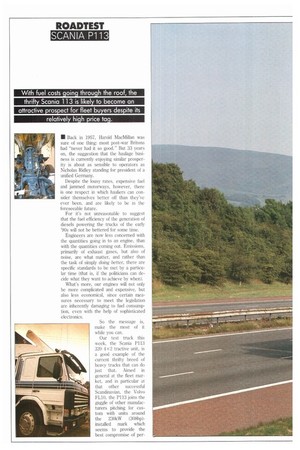ROADTEST SCANIA P113
Page 30

If you've noticed an error in this article please click here to report it so we can fix it.
• Back in 1957, Harold MacMillan was sure of one thing: most post-war Britons had "never had it so good." But 33 years on, the suggestion that the haulage business is currently enjoying similar prosperity is about as sensible to operators as Nicholas Ridley standing for president of a unified Germany.
Despite the lousy rates, expensive fuel and jammed motorways, however, there is one respect in which hauliers can consider themselves better off than they've ever been, and are likely to be in the foreseeable future.
For it's not unreasonable to suggest that the fuel efficiency of the generation of diesels powering the trucks of the early '90s will not be bettered for some time.
Engineers are now less concerned with the quantities going in to an engine, than with the quantities coming out. Emissions, primarily of exhaust gases, but also of noise, are what matter, and rather than the task of simply doing better, there are specific standards to be met by a particular time (that is, if the politicians can decide what they want to achieve by when).
What's more, our engines will not only be more complicated and expensive, but also less economical, since certain measures necessary to meet the legislation are inherently damaging to fuel consumption, even with the help of sophisticated electronics.
So the message is, make the most of it while you can.
Our test truck this week, the Scania P113 320 4x2 tractive unit, is a good example of the current thrifty breed of heavy trucks that can do just that. Aimed in general at the fleet market, and in particular at that other successful Scandinavian, the Volvo F1,10, the P113 joins the gaggle of other manufacturers pitching for custom with units around the 230kW (308hp)installed mark which seems to provide the best compromise of per




















































































